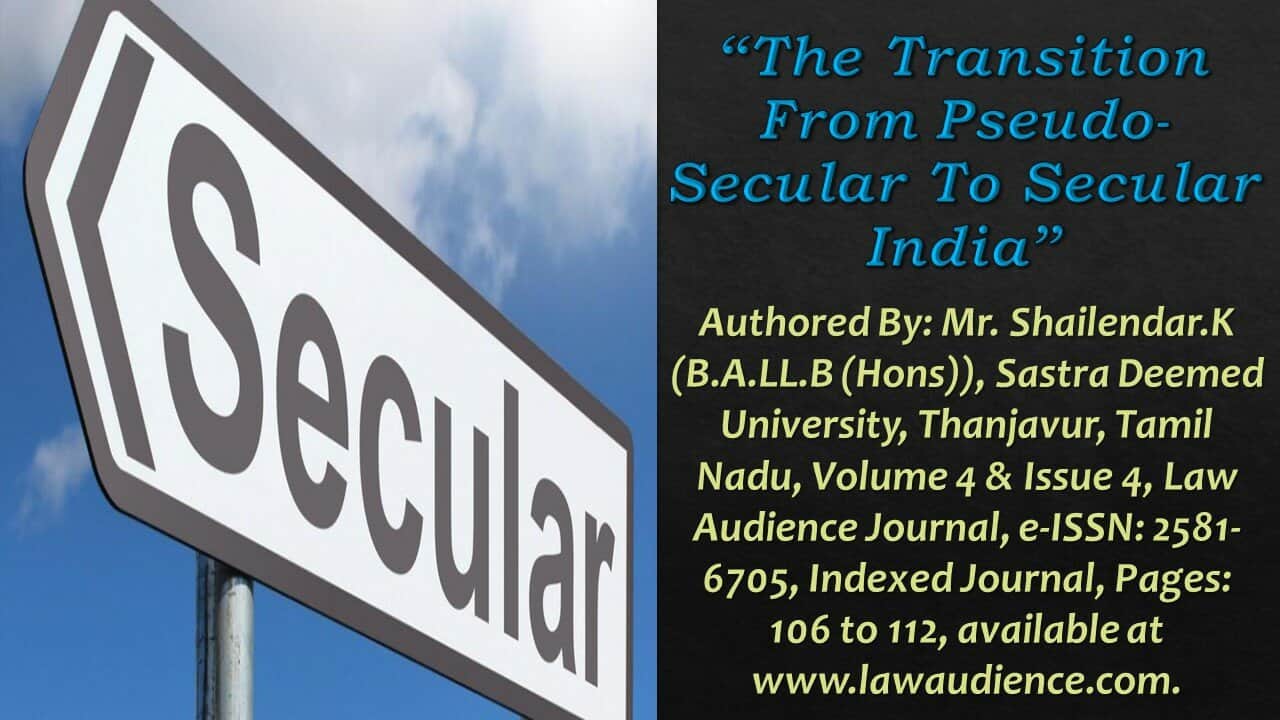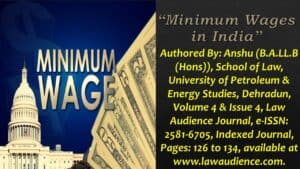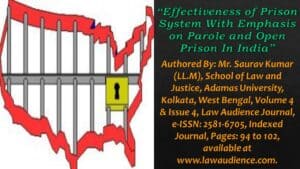Click here to download the full paper (PDF)
Authored By: Mr. Shailendar.K (B.A.LL.B (Hons)), Sastra Deemed University, Thanjavur, Tamil Nadu,
Click here for Copyright Policy.
I. WHAT IS RELIGIOUS FREEDOM?
Religious freedom in simple terms means citizens of a country are allowed to practice any religion without any restriction by the sovereign. Here the ‘any religion’ also includes no religion. Religious freedom is a fundamental right in many nations and it is also considered a basic human right under article 18 of the Universal declaration of human rights.
II. CONSTITUTIONAL SANCTION FOR RELIGIOUS FREEDOM:
Our constitutional makers have taken strenuous efforts to incorporate the concept of secularism in our Indian constitution though the term is not mentioned expressly. Secularism in a nutshell means ‘state has no official religion.’ The state must extend similar treatment to the Church, the Mosque, and the Temple.1 In S.R. Bommai vs. Union of India2, the hon’ble apex court held that secularism is a basic feature of the constitution. The state treats equally all religious denominations. Article 25 of the constitution gives the subjects of our state the freedom of conscience and the right freely to profess, practice, and propagate any religion. But everything has its limits. The same provision gives the state the right to restrict freedom on the grounds of public order, morality, and health. The overwhelming number of religious institutions in our country is because of Article 26 of our constitution which gives us the right to establish and maintain religious institutions.
III. COMPARISON BETWEEN INDIAN AND AMERICAN CONCEPTS OF SECULARISM:
The American concept of secularism is entirely different from its Indian counterpart. The first amendment to the US constitution states that ‘Congress shall make no law respecting an establishment of religion, or prohibiting the free exercise thereof; or abridging the freedom of speech, or of the press, or the right of the people peaceably to assemble, and to petition the Government for a redress of grievances.’ On the face of it, it may appear similar to Indian secularism. But the Indian constitution embodies the positive concept of secularism and has not accepted the American doctrine of secularism, i.e., the concept of erecting “a wall of separation between religion and state.” The concept of positive secularism separates spiritualism from individual faith. The state is neither anti-religion nor pro-religion. In the matter of religion, the state is neutral and treats every religion equally3 The real meaning of secularism in the Indian context is Sarva Dharma Sambhav meaning equal treatment and respect for all religions.4
The US state does not interfere in religious matters and it cannot make rules with respect to religious affairs whereas, in India, the state can interfere and make rules whenever necessary. This is because of the multiplicity of religions (Hinduism, Buddhism, Jainism, Sikhism, Islam, Christianity, and Judaism) that exist in India. Our Indian constitution has made it amply clear under what circumstances the government is duty-bound to interfere in Religious affairs. The instances where such interferences were made by the government and their impact will be discussed in detail below.
IV. WAS INDIA SECULAR DURING THE RULE OF INC?
In the words of Lord Dufferin, the largest left-wing party in India i.e., The Indian National Congress is the body of a microscopic minority. It has proved the statement right in many circumstances. One such instance includes the 1966 Hindu Massacre. On November 7th, 1966, when a large population of Hindu sadhus gathered in front of the parliament building demanding anti-cow slaughter law, the then congress government under the leadership of Smt. Indira Gandhi ordered fire. The official death toll is 375. However, people believe that it extends even more. The government failed to consider that the demand made by the sadhus is constitutionally sustainable as Article 48 of the constitution directs the state to take steps for prohibiting the slaughter of cows and calves and other milch and draught cattle.
Before discussing the second and third instances, let us look at The Constitution (42nd Amendment) Act, 1976, also known as the mini-constitution which inserted the word ‘secular’ in the preamble. It was merely to spell it out which is otherwise the part and parcel of our constitution. It was obviously meant to send message to the minorities in the context of birth control programs during the darkest period of Indian democracy. It was not like before 42nd Amendment India was not secular and it became secular only after the 42nd AA. India remained secular from the very beginning of the inception of the constitution. The second instance was the enactment of Muslim Women (Protection on Divorce Act), of 1986, by the then prime minister Shri Rajiv Gandhi diluting the supreme court judgment on Shah Banu’s case.5 The facts of the case include a 73 years old Muslim woman who went to court for divorce and maintenance under section 125 of Crpc as her husband divorced her by reiterating talaq three times. She has won the maintenance case in the local court which ordered her husband Khan to pay maintenance of Re 25 per month. However, Khan opposed the decree on the ground that Muslim personal law requires the husband to pay maintenance only for the iddat period after the maintenance.
Years later Banu approached the HC of MP for revision of maintenance and succeeded. In April 1985, SC delivered a historic judgment on the appeal filed by Khan against the order of HC. The apex court upheld the decree passed by the HC. This judgment was criticized by the Muslim hardliners as judicial overreach as it violated the Muslim personal laws and finally succeeded in convincing Rajiv Ji to enact the above-mentioned act. This was strongly criticized by many middle-class people especially Hindus who felt that Muslims are being pampered by the congress.6 The congress was egalitarian when it comes to the sentiments of Hindus but liberal to Muslims and refrained from interfering in their religious practices. It was seen as a grave injustice to the rights of women at a time when Human rights were gaining momentum all over the globe.
The third instance was the reopening of the gates of Babri Masjid and this decision was taken by Rajiv Gandhi immediately after the dilution of Shah Bano’s judgment. There was widespread suspicion among the Hindus after the enactment of MWA, in 1986. In order to wipe out the suspicion congress had taken a diplomatic stand and ensured that it did not hurt the sentiments of both the Hindus and Muslims. However, the decision to reopen the gates has not changed the status quo as the building continued to be a mosque while it functionally remains as a temple.7 Though it helped to douse the flame at that time, it did not help them in the long run. From all the above instances one can understand that the INC was never secular. Rather it was ‘pseudo secular’ which is a euphemism for the term minority appeasement. Even the regional Dravidian parties in Tamil Nadu claim themselves to be secular by appeasing minorities.
V. IS INDIA SECULAR AT PRESENT?
The sorry state of religious freedom in India changed when Shri Narendra Modi took over. From lay man’s perspective, the Hindutva model of governance may appear contradictory to the principles of secularism but in fact, ‘secularism has been rejuvenated’. Let us analyze the phrase in detail. Right from Shah Banu to Shaira Banu the injustice to Muslim women was at its peak. Shaira Banu’s case8 involves the case of a Muslim woman being divorced by her husband by instantaneous triple talaq. She moved the apex court against the disastrous Muslim Women (Protection on Divorce Act), 1986, as it violated the petitioner’s right to equality which is guaranteed under article 14 of the constitution, and also the said act did not pass the test laid down in article 13 of the constitution. Further, it also violates articles 15 and 21. The apex court in a 3:2 majority held that the MWA, 1986, is unconstitutional. On 30th July 2019, the parliament passed the Muslim women (Protection Of Rights On Marriage) bill which ended the cruel practice of triple talaq. Thus, it took 33 years to correct the historic blunder made by Rajiv Gandhi. Hope the said legislation provides justice to the crores of deserted women like Shah Bano.
When it comes to the Anti cow slaughter bill which is at present enacted in many states ruled by right-wing parties, people started to look at the issue through the glasses of Hindutva and majority appeasement. But what people failed to consider is that cow slaughter in general is the crime of utmost savagery. Just because the choice of food is the fundamental right to life under article 21 of the constitution9, the ethical values of the society cannot be compromised. The cow is considered a universal symbol of motherhood and compassion. When compared to other cattle, cow serves a useful purpose for mankind. Its milk forms the core part of the diet right from infants to elderly people. Many worldwide research carried out on the gomuthra (cow urine) concluded the medicinal properties associated with it. Cow dung is believed to have antibacterial properties since time immemorial in our country. It is also used as raw material in gobar gas plants. When we view it from a religious perspective, Hindus consider the cow as an incarnation of Lord Vishnu. The cow has a special place in Hindu religious literature like Manusmriti, Manu samhita, and Rig veda. One must note that Manusmriti is considered a source of Hindu law. Is it not cruel to kill such an animal that has spiritual, moral, social, and cultural values associated with it?
Moreover, the supreme court in the case of Mohd. Hanif Quareshi vs. State of Bihar10, has held that the sacrifice of a cow on the Bakrid day was not an essential part of Mohammedan religion and hence could be prohibited by the state under clause (2)(a) of Article 25. Animal cruelty laws based on sentimental grounds in India is not novel legislation of its kind. US house also passed a similar act ‘Dog and Cat meat trade prohibition act of 2017’ to ban the slaughter of dogs and cats in response to the demand made by canine lovers. Very soon nationwide ban on cow slaughter will be a reality.
By the same token, let us try to analyze the Anti-conversion bill also known as the Love Jihad act which is enforced in many BJP-ruled states: Uttar Pradesh, Madhya Pradesh, Haryana, and Karnataka. The main object of the legislation which is highly misconceived by society is to prevent forcible religious conversion especially the conversion during the marriage. There are numerous cases in our country where women fell victim to forcible religious conversions.
In Rev Stainislaus vs. the State of M.P11, the apex court held that “If an attempt is made to raise communal passion, e.g., on the ground that someone has been forcibly converted to another religion, it would, in all probability, give rise to an apprehension of a breach of the public order, affecting the community at large. Therefore, legislation prohibiting forcible conversion of one’s own religion in the interest of public order can be passed and is valid.” More so the composition of Hindus in our country is reducing at an alarming rate. We Hindus are under a moral obligation to safeguard the oldest religion in the world.
VI. HOW TO ACHIEVE ABSOLUTE RELIGIOUS FREEDOM?
Absolute religious freedom can be found only on paper. Even the countries which claim themselves to be ‘strictly secular’ aren’t actually secular in reality. Let us take the US which has a watertight constitutional provision separating the church from the state. In contrast to it ‘In God we trust’ is its official motto since 1956 and it is printed in its currency. Furthermore, the mention of “one nation, under god” in the pledge of allegiance sparks debate on American secularism. Defenders of that ideology consider it a mere patriotic ritual. But it is an endorsement of a religious belief. Moreover, racial equality and anti-racism are the facets of secularism in modern society.
After the George Floyd murder, one can understand how healthy racial equality is in the US and hence secularism. Religious intolerance is not something new in the US. There was a conspiracy theory that surrounded the world during the 20th century that the Bhagwan Shree Rajneesh (famously called philosopher Osho) was poisoned by the then US president Ronald Reagan, a Christian fundamentalist who feared that the entire US will be converted to Hinduism if Osho is left alive for some time.12 Even when the U.S. government has allowed for a fair amount of reference to religion in public rituals and exercises what actually proscribes India from compromising its stand of absolute secularism?
VII. CONCLUSION:
In a highly populous country like India, the majority opinion cannot be suppressed. Since they form the major portion of the electorate, the policies of the government will necessarily be the reflection of their views. Indian secularism is the agglomeration of all the religions and denominations.
Cite this article as:
Mr. Shailendar.K, “The Transition From Pseudo-Secular To Secular India”, Vol.4 & Issue 4, Law Audience Journal (e-ISSN: 2581-6705), Pages 106 to 112 (2nd November 2022), available at https://www.lawaudience.com/the-transition-from-pseudo-secular-to-secular-india/.
Footnotes:
- United States v. Ballard
- AIR 1994 SC 1918
- S.R. Bommai v. Union of India
- Gandhi Ji’s quotes
- Shah Bano case
- ‘Congress after Indira’ by Zoya Hasen
- ‘My years with Rajiv’ by Wajahat Habibullah
- Shaira Banu v. Union of India
- Saeed Ahmed v State of U.P., Misc. Bench No. 6871 of 2017
- AIR 1958 SC 731
- AIR 1977 SC 908
- Was Bhagwan Shree Rajneesh Poisoned by Ronald Reagan’s Am by Sue Appleton




